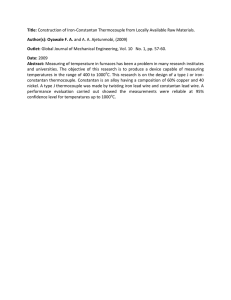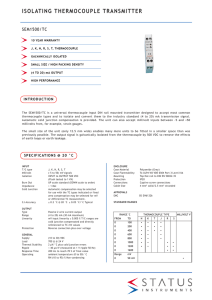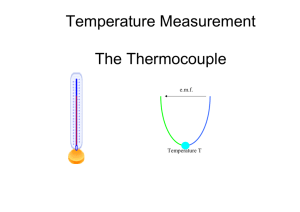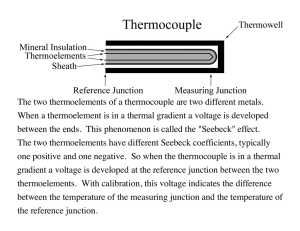21. Measurement of the contact potential of a thermocouple
advertisement
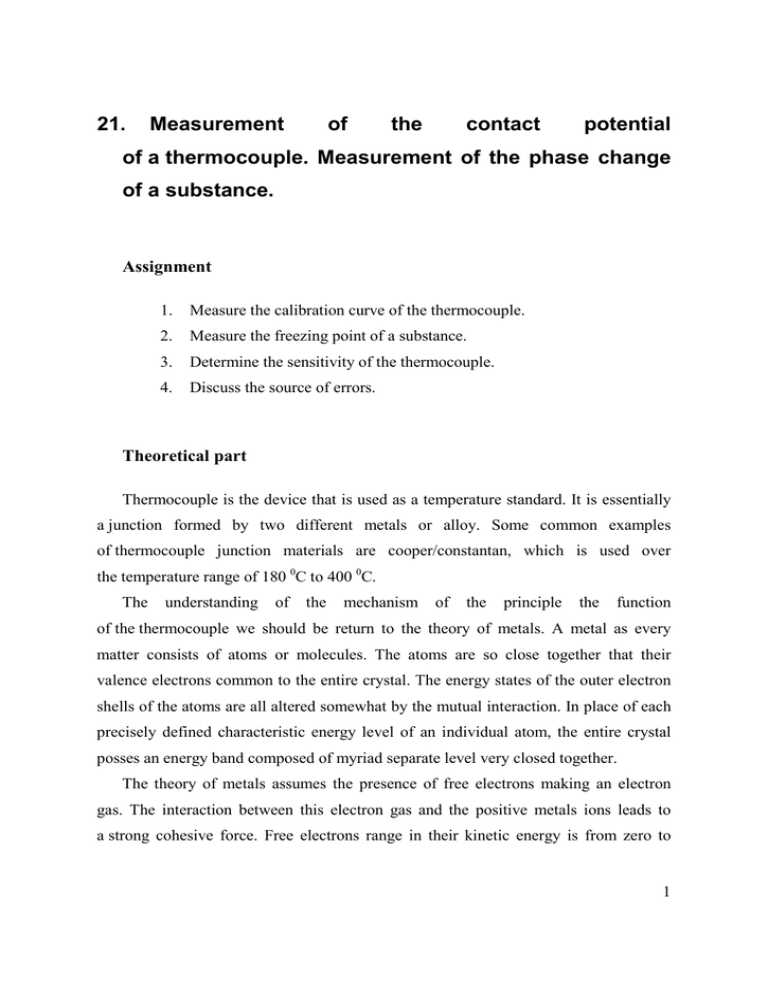
21. Measurement of the contact potential of a thermocouple. Measurement of the phase change of a substance. Assignment 1. Measure the calibration curve of the thermocouple. 2. Measure the freezing point of a substance. 3. Determine the sensitivity of the thermocouple. 4. Discuss the source of errors. Theoretical part Thermocouple is the device that is used as a temperature standard. It is essentially a junction formed by two different metals or alloy. Some common examples of thermocouple junction materials are cooper/constantan, which is used over the temperature range of 180 0C to 400 0C. The understanding of the mechanism of the principle the function of the thermocouple we should be return to the theory of metals. A metal as every matter consists of atoms or molecules. The atoms are so close together that their valence electrons common to the entire crystal. The energy states of the outer electron shells of the atoms are all altered somewhat by the mutual interaction. In place of each precisely defined characteristic energy level of an individual atom, the entire crystal posses an energy band composed of myriad separate level very closed together. The theory of metals assumes the presence of free electrons making an electron gas. The interaction between this electron gas and the positive metals ions leads to a strong cohesive force. Free electrons range in their kinetic energy is from zero to 1 a maximum of ε f , which is called the Fermi level (energy). The presence of such free electrons accounts nicely for the high electrical and other properties of metals. If we connect two metals of various values of the Fermi level together and the heat is applied to this compound current is to be produced. The production of current by the thermocouple depends on the existence of two junctions between different materials at different temperatures as is shown in Fig.11.1. εf εI ε II I ++++ +++ ++ + II - - - - - - - x U x Fig.11.1 The electrons from material I having higher value of Fermi level will be transferred into the metal II which obeys the lower value of the Fermi energy. The result of this effect is the higher amount of electrons in second metal and decreasing the number of electrons in first metal. Consequently, one metal is made negative (excess electrons) and the other is made positive (deficient in electrons). This phenomenon causes the potential difference between these metals. This potential difference is called the contact potential U. For any pair of metals the magnitude of the contact potential depends on difference between the Fermi levels at the contact surface as Ue = ε I − ε II (11.1) where ε I is the Fermi energy of metal I, ε II is the Fermi energy of the metal II and e is the charge of the electrone. 2 If the temperature of both metals I and II will be the same the value of potential difference will be zero. If the temperature increases by ∆T the potential U increases, too. It means that U = f (∆T ) (11.2) I T + ∆T T II Fig.11.2 Generally, exactly expression for this dependence is more complicated and it is given by the principle of quantum physics. T.J. Seebeck (1770-1831) discovered practical application of the variation in contact potential with temperature. He found that, if two different metals such as copper and constantan are joined to form a closed loop (see Fig.11.2) and one junction is kept in different temperature as the other, electric current will flow in the closed loop. This effect is known as Seebeck’s effect. At the small temperature differences the equation describing this effect can be written as U = α s ∆T (11.3) where α s is called Seebeck`s coefficient. This coefficient is defined as αs = 1 dε F e dT where e is the charge of the electron, (11.4) dε F is the derivative of the Fermi energy with dT respect to the change of the temperature. Equation (11.3) can be also written on the form U = (α I + α II )∆T (11.5) where α I and α II is Seebeck`s coefficient of the first conductor and second one, respectively. 3 The method-practical part There are many different kinds of the thermocouples. Plot of potential versus temperature for three kinds of thermocouples is shown in Fig.11.3 U (mV) 80 chromel / constantan 60 40 copper / constantan platinum / platinum + 10 % rhodium 20 0 1000 500 0 1500 t ( C) Fig.11.3 The precise measurement of the temperature by the thermocouple requires the precise measurement of the contact potential versus temperature. This curve is called calibration one. The principle of measurement is as follows: The test junction is placed in the material whose temperature is to be measured and the opposite end of the thermocouple is maintained at reference temperature, usually in a water-ice mixture. Scheme is shown in Fig.11.4 ∆U hot junction cold junction Fig.11.4 4 When the temperature of the test junction is other than 0 0C, the contact potential U appears between two junctions. Its value is proportional to the temperature difference and therefore can be used to measurement of an unknown temperature. There are two methods to measure the contact potential a direct method and a balance one. Thermocouple is often used for the measurement of the temperature–time dependence of a substance. This method is very important for determination of the temperature of the phase changes of the substance. We shall measure the temperature of the alloy that changes its state from liquid’s form to solid’s form. Typical time-temperature dependence of a substance is shown in Fig.11.5. t °C freezing point phase change τ s Fig.11.5 From this graph we can see that there is certain interval when temperature does not change with time. In this time interval the physical characteristics of the substance will be changed from one form to another. This change is called phase change. All such phase changes cause the change of internal energy. This energy required is called the heat of transformation. The phase changes can be described in terms of rearrangement of molecules, when heat is added (melting point) or removed (freezing point) from a substance. Measurement Apparatus: thermocouple, thermometer, thermos flask, ice, heater flask, substance, computer, multimeter. 5 Experimental procedure: Connect the apparatus (circuit diagram is shown in Fig.11.6). Measure the calibration curve (temperature-voltage dependence) of the thermocouple. Note the “cold” junction will be held at the constant temperature of 0 °C and the temperature of the “hot” junction will be to vary up to 200 °C. Heat the measured substance up to 200 °C. Measure the time-voltage dependence in time interval of 5 s of cooling substance. Note the computer possesses this part of experiment. Program is marked as “termoclanok” in the computer. V computer Fig.11.6 Calculation: Draw the calibration curve of the thermocouple using the computer. Calculate the value of Seebeck’s coefficient by the method of linear regression. Determine the value of temperature of freezing point of the substance measured timevoltage curve and calibration one. Compare this result with accepted table values. Approximately determine the sensitivity (in milivolts per degree) of the thermocouple. Provide the analysis of your measurement. 6
